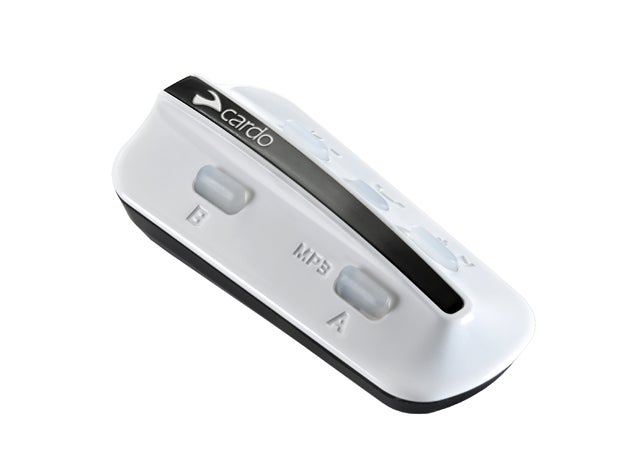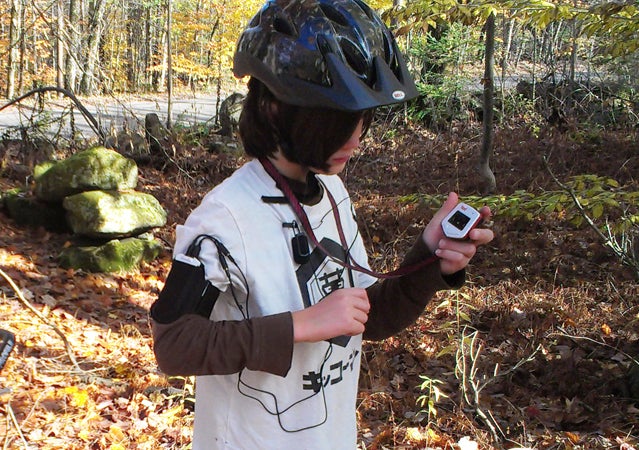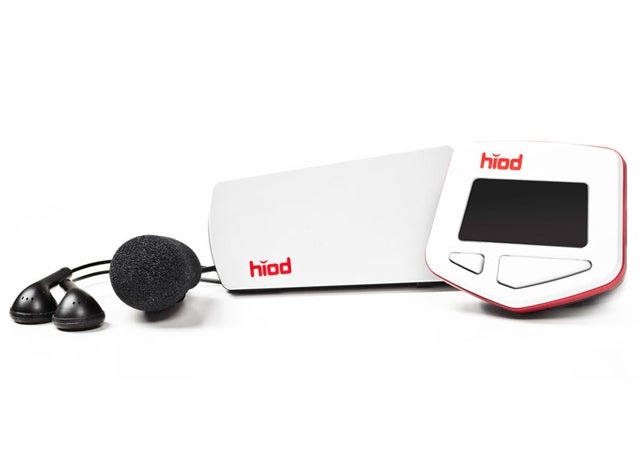The was an awesome surprise. The Hiod is a little Swedish gadget lets you talk to your cycling partners seamlessly. It’s a device I’d never even heard of before, and yet it quickly became absolutely essential to my workouts. There have been walkie-talkie-based bike headsets on the market, but I’ve never tried anything with the long-distance range, full-duplex sound, and clarity of the Hiod, which uses the Bluetooth wireless system to relay a person’s voice from bike to bike. It currently has a competitor in this space, the Bluetooth-powered Cardo; both are just hitting the market.
For $219, you get a pair of earphones and a microphone attached to a voice unit you wear in a neoprene holster on your arm. A separate wireless controller unit with a small monochrome screen attaches to your handlebars. It has two buttons: the left button browses, and the right one selects one of four functions. You can chat with friends in your peloton, listen to music on your cell phone via Bluetooth, make calls on your phone, or track speed and distance using the GPS on your phone (this function is for Android phones only).
The device, named after a behind your tongue, has a clean interface and spare design aesthetic like other nice Swedish things—Swedish , for example, and those at Ikea. Its OLED screen is vivid in any light. Hiod One units have an advertised range of 400 yards, though our tests found the distance shorter (more on that on the next pages). Both units are IPX7 waterproof and together weigh four ounces. The Hiod came out in Europe in June. It is currently sold in the U.S. by (though it’s still awaiting FCC approval … go figure).
The Good Stuff
The Bad Stuff
The Competition
Hiod One: The Competition

The $275 from Pittsburgh’s Cardo consists of a single unit that straps to your helmet, letting you talk via Bluetooth to other (similarly equipped) cyclists. You can also connect to your cell phone to listen to music, make and take calls, and listen to GPS directions. It doesn’t have a screen, however, and no speed and distance data from your cell.
There are also Bluetooth units for motorcycles, but they are heavier and don’t include the mounts for a bike. Adventurous users can also try the to Bluetooth communication.
Overall, I was pleased with my first brush with the Hiod system, and will be sad when the review period ends for these devices. To test them, I took a serious 30-mile ride with a friend, and a mountain hike with my son. Both revealed the strengths and weaknesses of these new technologies. I’ll give you the lowdown on the good and bad after the jump.
Hiod One: The Bad Stuff

The Hiod One is the first version from Swedish startup . So it’s probably for cyclists moderately comfortable with new technology. In other words, if the digital clock on your microwave has never been set for the right time, forget it.
Case in point: Sometimes the Bluetooth signals get fouled up. During my ride with Michel, his Hiod disassociated itself with the voice unit. I had to do a hard factory reset right there on the pavement of Route 9. The guy just wanted to get on with his ride.
Another example: My son accidently clicked on the voice-dialing feature while we were walking through the woods. He said, “What’s that sound” into the microphone, and the system thought he said “Call Dave Brown.” It immediately accessed my cell phone’s address book and dialed the personal cell phone number of a rather imposing editor that usually gives me cold chills to talk with anyway. (The call went to voicemail.)
It’s clear that the Hiod is a step into the future. It makes good use of a sophisticated technology you usually have on you already (your cell phone). It uses small wearable electronics that hug close to your body. And it uses a good digital wireless radio standard for flawless communication. The utility is there, but it’s still a lot of hassle for a simple country bike ride. This is really a design problem and when the product designers can finally tame all the hassles, it will have a broad appeal, for cyclists, and probably kayakers and hikers too.
Hiod One: The Good Stuff

Good communication while riding is underrated. When I used the Bluetooth devices from Hiod with a friend last weekend, it felt both safer and more convenient. For about half the time, my riding partner Michel was hammering the ride and I could barely hold on. But still, he could feed me directions and upcoming turns from 100 yards back. When I finally caught up with him, we were riding against a 20mph wind, so I drafted and we could still talk freely. The sound quality is so good it’s like chatting on a land line in a quiet room, the type of clarity where you can hear everything. We found that the units typically work about 100 yards away because the range is impacted by obstacles, such as the rider’s body and any trees between the units. If the units are held perfectly line of sight, we found we could talk as much as 300 yards away.
In the second half of our ride, I asked that we slow down and enjoy the Western Massachusetts countryside. It was a chance to talk about family, kids, and work. But with the Hiod units, we were able to ride single file, which always feels safer on narrow rural streets.
The Hiod was easy to setup. With the press of a few buttons, you can program in your name, then the names of your cycling partners show up on the Hiod’s small amber screen. Just press a button to immediately talk to any one of them (unlike walkie-talkie systems, you can only talk to one person at a time).
It was nice to access the simple interface on the handlebars with gloved hands. There were many points in the ride where music at low volume was appropriate (straight country road, good visibility), but I’d never want to fiddle with my cell phone screen to locate the Play button. The Hiod let me turn it on and off at will. Likewise the HIOD provides a simplified interface to start and end a call (though there’s the question of whether we need more distracted riders when there are so many distracted drivers in the world).
The hidden killer app in the Hiod is its ability to double as a simple cycle computer. It won’t give you any serious metrics like cadence and power, but it exploits the GPS in your phone to deliver accurate distance, speed, and current time. Sure, any $20 bike speedometer will do the same thing, but it’s nice to have the feature on the high-contrast OLED screen.


